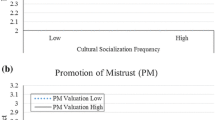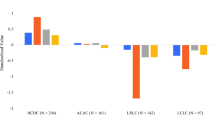Abstract
The present study related generational status, marital status, parental overprotection (control), and cultural value conflict to self-esteem and depression among first and second-generation Asian Indian immigrant women in the south-midwestern United States. Self-report data from 73 community-dwelling women supported the hypotheses that unmarried and second-generation women would report greater maternal control and cultural value conflict than would married and first-generation women. Second-generational status, high maternal control, and high cultural value conflict correlated with higher depressive symptomology; being married, low maternal control, and low cultural value conflict were related to high self-esteem. Regression analyses indicated a mediating role for cultural value conflict for depression symptom predictors, but not for self-esteem predictors. Open-ended response data provided enriched understanding of these women’s cultural and family conflicts.


Similar content being viewed by others
References
Abouguendia, M., & Noels, K. A. (2001). General and acculturation-related daily hassles and psychological adjustment in first-and second-generation South Asian immigrants to Canada. International Journal of Psychology, 36, 13–173.
Baptiste, D. (2005). Family therapy with East Indian immigrant parents rearing children in the United States: Parental concerns, therapeutic issues, and recommendations. Contemporary Family Therapy: An International Journal, 27, 345–366.
Baron, R. M., & Kenny, D. A. (1986). A moderator-mediator variable distinction in social psychological research: Conceptual, strategic, and statistical considerations. Journal of Personality and Social Psychology, 51, 1173–1182.
Boyatzis, R. E. (1998). Transforming qualitative information. London: Sage Publications.
Cabassa, L. J. (2003). Measuring acculturation: Where we are and where we need to go. Hispanic Journal of Behavioral Sciences, 25, 127–146.
Castillo, L. G., Conoley, C. W., & Brossart, D. F. (2004). Acculturation, White marginalization, and family support as predictors of perceived distress in Mexican American female college students. Journal of Counseling Psychology, 51, 151–157.
Castro, V. S. (2003). Acculturation and psychological adaptation. Westport, CT: Greenwood Press.
Chacko, E. (2003). Marriage, development, and the status of women in Kerala, India. Gender and Development, 11, 52–59.
Cohen, J. (1960). A coefficient of agreement for nominal scales. Educational and Psychological Measurement, 20, 37–46.
Cohen, J. (1992). A power primer. Psychological Bulletin, 112, 155–159.
Cohen, J., Cohen, P., West, S., & Aiken, L. (2003). Applied multiple regression/correlational analysis for the behavioral sciences (3rd ed.). Mahwah, NJ: Lawrence Erlbaum.
Das, A. K., & Kemp, S. F. (1997). Between two worlds: Counseling South Asian immigrants. Journal of Multicultural Counseling and Development, 25, 23–34.
Dasgupta, S. D. (1998). Gender roles and cultural continuity in the Asian Indian immigrant community in the United States. Sex Roles, 38, 953–973.
Dasgupta, S. D., & Dasgupta, S. (1996). Public face, private space: Asian Indian women and sexuality. In N. Maglin & D. Perry (Eds.), Bad girls/Good girls: Women, sex, and power in the Nineties (pp. 226–247). New Brunswick, NJ: Rutgers University Press.
Deepak, A. (2005). Parenting and the process of migration: Possibilities within South Asian families. Child Welfare League of America, 40, 585–606.
Dugsin, R. (2001). Conflict and healing in family experience of second-generation emigrants from India living in North America. Family Process, 40, 233–241.
Durvasula, R. S., & Mylvaganam, G. A. (1994). Mental health of Asian Indians: Relevant issues and community implications. Journal of Community Psychology, 22, 97–108.
Farver, J. M., Narang, S. K., & Bhadha, B. R. (2002). East meets west: Ethnic identity, acculturation, and conflict in Asian Indian families. Journal of Family Psychology, 16, 338–350.
Fischer, J., & Corcoran, K. (1994). Measures for clinical practice: A sourcebook (Vol.2). New York: The Free.
George, P. O. (2002). Suicides in Kerala: An analysis. Retrieved March 11, 2005, from http://maithrikochi.org/resources.htm
Hernandez, D. J., & Chaney, E. (1998). From generation to generation: The health and well-being of children in immigrant families. Washington D.C.: National Academy Press.
Hicks, M. H., & Bhugra, D. (2003). Perceived causes of suicide attempts by U.K South Asian women. The American Journal of Orthopsychiatry, 73, 455–462.
Inman, A. G., Constantine, M. G., & Ladany, N. (1999). Cultural value conflict: An examination of Asian Indian women’s bicultural experience. In D. S. Sandhu (Ed.), Asian and Pacific Islander Americans: Issues and concerns for counseling and psychotherapy (pp. 31–41). Commack, NY: Nova Science Publishers.
Inman, A. G., Howard, E. E., Beaumont, R. L., & Walker, J. A. (2007). Cultural transmission: influence of contextual factors in Asian Indian immigrant parents’ experiences. Journal of Counseling Psychology, 54, 93–100.
Inman, A. G., Ladany, N., Constantine, M. G., & Morano, C. K. (2001). Development and preliminary validation of the Cultural Values Conflict Scale for South Asian women. Journal of Counseling Psychology, 48, 17–27.
Jambunathan, S. (2000). Comparison of parenting attitudes among five ethnic groups in the United States. Journal of Comparative Family Studies, 31, 395–406.
Jayakar, K. (1994). Women of the Indian subcontinent. In L. Comas-Diaz & B. Greene (Eds.), Women of Color (pp. 161–181). New York NY: Guildford Press.
Joseph, R. B. (1992). Perceived change of immigrants in the United States: A study of Kerala (Asian Indian) immigrant couples in Greater Chicago. (Doctoral dissertation, Loyola University, 1992). Dissertation Abstracts International, 52(12-A), 4479.
Kallivayalil, D. (2004). Gender and cultural socialization in Indian immigrant families in the United States. Feminism & Psychology, 14, 535–559.
Kandamuthan, M. (1998). Preliminary findings of the psycho-social factors for attempt of suicide in Kerala. National Institute of Mental Health and Neurosciences Journal, 16, 261–270.
Kenny, D. A. (1979). Correlation and causality. New York: Wiley.
Krishnan, A., & Berry, J. W. (1992). Acculturative stress and acculturation attitudes among Asian Indian immigrants to the United States. Psychology and Developing Societies, 4, 187–212.
Kwak, K., & Berry, J. W. (2001). Generational differences in acculturation among Asian families in Canada: A comparison of Vietnamese, Korean, and East Asian groups. Journal of Instructional Psychology, 36, 152–162.
Parayil, G. (1996). The ‘Kerala model’ of development: development and sustainability in the Third World. Third World Quarterly, 17, 941–957.
Parker, G., Tupling, H., & Brown, L. B. (1979). A parenting bonding instrument. The British Journal of Psychiatry, 30, 115–126.
Patel, S.P., & Gaw, A.C. (1996). Suicide among immigrants on the Indian subcontinent: A review. Psychiatric Services (Washington, D.C.), 47, 517–521.
Pomerantz, E. (2000). Developmental differences in children’s conceptions of parental control: They love me, but make me feel incompetent. Merrill-Palmer Quarterly, 46, 140–167.
Prathikanti, E. (1997). East Indian families. In E. Lee (Ed.), Working with Asian Americans: A guide for clinicians (pp. 113–125). New York: Guilford Press.
Radloff, L. S. (1977). The CES-D Scale: A self-report depression scale for research in the general population. Applied Psychological Measurement, 1, 385–401.
Raleigh, V. S. (1996). Suicide patterns and trends in people of Indian subcontinent and Caribbean origin in England and Wales. Ethnicity & Health, 1, 55–63.
Ranganath, V. M., & Ranganath, V. K. (1997). Asian Indian children. In G. Johnson-Powell, J. Yamamoto, et al. (Eds.), Transcultural child development: Psychological assessment and treatment (pp. 103–125). NY: John Wiley & Sons.
Rosenberg, M. (1989). Society and the adolescent self-image (revisedth ed.). Middletown, CT: Wesleyan University Press.
Salamah, N. (1991). Self-esteem and parental controls in late adolescence and young adulthood. Derasat Nafseyah, 1, 679–702.
Saran, P., & Eames, E. (1980). The new ethnics: Asian Indians in the United Sates. New York: Praeger.
Segal, U. (1991). Cultural variables in Asian Indian families. Families in Society, 72, 233–241.
Segal, U. (1998). Asian Indian families. In C. Mindel, R. Habenstein & R. Wright Jr. (Eds.), Ethnic families in America: Patterns and variations (pp. 331–360). Upper Saddle River, NJ: Prentice Hall.
Shams, M., & Williams, R. (1995). Differences in perceived parental care and protection and related psychological distress between British Asian and non-Asian adolescents. Journal of Adolescence, 18, 329–348.
Sobel, M. E. (1982). Asymptolic confidence intervals for indirect effects in structural equation models. In S. Leinhart (Ed.), Sociological methodology 1982 (pp. 290–312). San Francisco: Jossey-Bass.
Suárez-Orozco, C., & Doucet, F. (2006). Migration and Ethnic Minorities. In L. Romanucci-Ross, G. A. De Vos & T. Tsuda (Eds.), Problems and Prospects for the Twenty-first Century, 4th Edition (pp. 157–188). Lanham, MD: Altamira.
Talbani, A., & Hasanali, P. (2000). Adolescent females between tradition and modernity: Gender role socialization in South Asian immigrant culture. Journal of Adolescence, 23, 615–627.
Wakil, S. P., Siddique, C. M., & Wakil, F. A. (1981). Between two cultures: A study in socialization of children of immigrants. Journal of Marriage and the Family, 43, 929–940.
Author information
Authors and Affiliations
Corresponding author
Rights and permissions
About this article
Cite this article
Varghese, A., Rae Jenkins, S. Parental Overprotection, Cultural Value Conflict, and Psychological Adaptation among Asian Indian Women in America. Sex Roles 61, 235–251 (2009). https://doi.org/10.1007/s11199-009-9620-x
Received:
Accepted:
Published:
Issue Date:
DOI: https://doi.org/10.1007/s11199-009-9620-x




